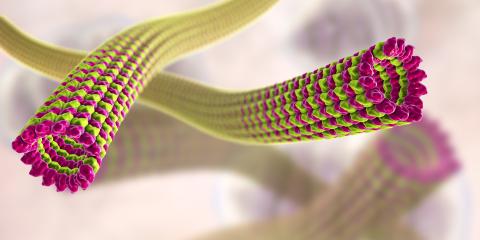
Carsten Janke: Deciphering the "tubulin code"
Carsten Janke is a researcher at the Genome Integrity, RNA and Cancer unit (GIRC – Univ. Paris-Saclay/National Centre for Scientific Research, CNRS/ Institut Curie) and leader of the Controlling Microtubule Dynamics and Function with the Tubulin Code team. With the team, he is trying to understand the role of post-translational modifications of microtubules, the long molecules that make up the skeleton of eukaryotic cells. At a time when the scientific community suspects that modifications to these proteins contain information in the form of "code", the researcher's journey demonstrates how he is making one of modern science's most fascinating questions his own.
A native of Saxony (Germany), Carsten Janke began his scientific career somewhat by chance: encouraged by his teachers to enrol in mathematics at Leipzig University, he had his first inkling that he wouldn't thrive in this discipline. He preferred biology, boosted by the proliferation of new molecular techniques in the 1980s, and devoted his studies to this discipline. He chose to do his PhD thesis at the Max Planck Institute for Human Cognitive and Brain Sciences in Leipzig, which uses state-of-the-art techniques.
This is when he came across microtubules for the first time. These elongated molecules – filaments formed from the tubulin protein – are one of the building blocks of the cytoskeleton, which is involved in major cellular functions. While his thesis focused on the tau protein, which was suspected – and rightly so – of being linked to Alzheimer's disease, one of the properties of this protein was to bind itself to microtubules in order to stabilise them.
Embracing academic freedom
At this stage, Carsten Janke had still not decided on the scientific subject that was to be the focus of his future research. After defending his thesis, he hoped to take advantage of the freedom that short post-doctoral contracts offered, enabling him to discover research in new countries – and decided to head to France. At the end of the 1990s, post-doctoral fellowships were only just being introduced and were still relatively rare. In Orléans, however, one laboratory agreed to take on the young researcher. Here, microtubules were to cross Janke's path a second time: he learnt that these cytoskeletal components are susceptible to a large number of post-translational modifications.
These chemical modifications are made to the tubulin protein itself, once it has been made by the cell from the information contained in the DNA in the nucleus. This involves either the addition or removal of functional or peptide groups. As a microtubule is made up of a very large number of tubulin molecules, each of which can be modified independently, "we get an infinite number of possible combinations of modifications. Scientists then began to hypothesise that there was a 'tubulin code'," Carsten Janke recalls.
Growing interest
This hypothesis also appealed to the researcher. By the end of his contract in Orléans, he was fluent in French, and even though he had made a number of contacts that would prove decisive for the rest of his career, he was facing a major obstacle: he couldn't find a host team in France that would allow him to work on the "tubulin code". So, he decided to move again, this time to Scotland, where he found a subject that was to become a springboard in his research: cell division in yeast. Although this field of study was not directly linked to the "tubulin code", it wasn't completely unconnected with microtubules, since they are very much involved in cell division.
With this new postdoctoral fellowship, Carsten Janke was able to fine-tune his expertise in molecular biology techniques. At the end of his contract, he was also granted funding from the European Molecular Biology Organization (EMBO), which he used to return to France. He joined Bernard Eddé's team, a scientist who discovered a post-translational modification of microtubules, at the Centre for Biochemical and Macromolecular Research (CRBM) in Montpellier.
On the hunt for enzymes
For Carsten Janke, it was time to devote himself completely to what had become his passion: the post-translational modifications of microtubules and the role they play. He decided to apply his mastery of molecular biology to the modification discovered by Bernard Eddé's team. Together, they identified the DNA sequence encoding the tubulin-modifying enzyme, and then searched the DNA for genes of other similar enzymes. "I searched the genome like crazy and, by aligning and reconstructing the sequences, I found segments that resembled the first proteins I'd identified."
Thanks to molecular cloning, the team was able to obtain mice that express these genes intensely. Scientists then observed how these new enzymes modified the tubulin. Using this technique, Carsten Janke discovered a number of new enzymes responsible for various types of post-translational modification.
Laboratory mice
Off the back of these initial successes, the team began to look ahead to the next stage: identifying the consequences of deregulation of post-translational modifications of microtubules in mice. In 2010, the team relocated to the Curie Institute in Orsay, where Carsten Janke continued his research on the "tubulin code" in the Genome Integrity, RNA and Cancer unit (GIRC – Univ. Paris-Saclay/CNRS/Curie Institute). His functional research proved more complex than expected, as these tubulin modifications often have only very slight impacts on the general condition of the mice. "These mice seem to be doing very well if you just take a quick look at them," confirms Carsten Janke. Only a thorough examination will reveal a few alterations, some of which only appear over the mice's lifetime.
For example, in one of the modified lines of mice, the team noticed a drop in male fertility. This led Carsten Janke's team to investigate the role of post-translational modifications of microtubules in sperm function. The flagellum of these reproductive cells is made up of nine pairs of microtubules arranged around a central pair. These nine pairs of microtubules undergo numerous post-translational modifications and are linked together by motor proteins. These motor proteins create small movements which, if synchronised, induce the correct undulation of the sperm flagellum. Carsten Janke's team, in collaboration with teams from Bonn and Dresden in Germany, have shown that the lack of one of the modifications on the flagellum microtubules prevents the proper functioning of the molecular motors. As a result of this anomaly, the sperm no longer swims in a straight line, and instead spins in circles, reducing the probability of it encountering an ovum.
A code based on probability
Today, the researcher is curbing ideas about the existence of a tubulin code that is as determined as the genetic code. "This generates patterns, which we can only interpret as the probability of an event occurring. Over the long term, however, this is enough to influence the organism on a macroscopic level."
There are still a lot of grey areas to clear up, and after studies – and discoveries – at the level of both molecules and organisms, Carsten Janke is now keen to understand the mechanisms at play at the cellular level. The effect of post-translational modifications of microtubules at this scale is still a mystery – but certainly won't be for long!

